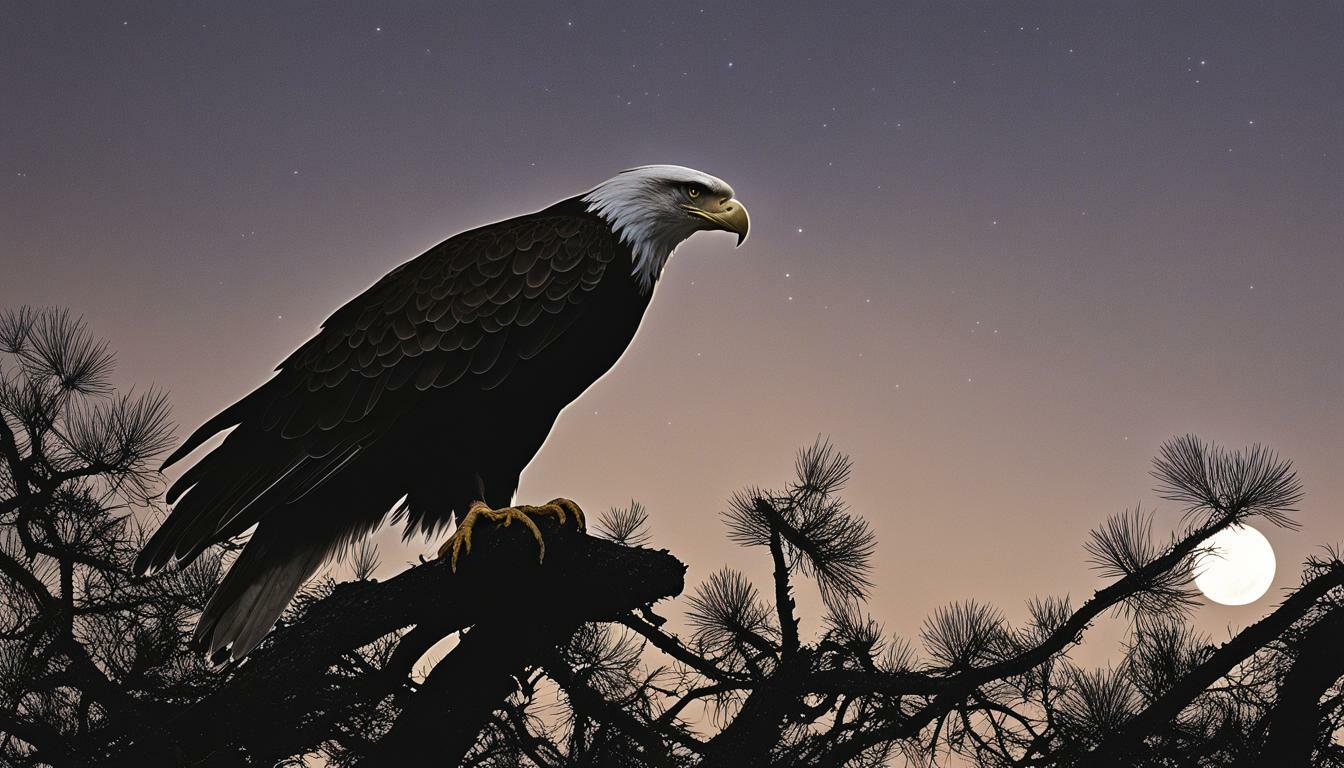Have you ever wondered if eagles hunt during the dark hours of the night? The answer might surprise you. Eagles are one of the few raptors that have the ability to hunt at night, making them even more impressive predators. In this article, we’ll explore the nocturnal hunting behavior of eagles and uncover their nighttime hunting habits.
Eagles are equipped with exceptional vision and hunting strategies that make them effective predators in low-light conditions. Their eyesight is up to eight times better than that of humans, allowing them to scan the ground and spot prey from great distances. They also have a unique hunting pattern of soaring high above the ground and using their sharp vision to search for potential prey.
Key Takeaways
- Eagles have the ability to hunt at night due to their exceptional vision and hunting strategies.
- Their sharp eyesight allows them to scan the ground and spot prey in low-light conditions.
- Eagles use their unique hunting pattern of soaring high above the ground to search for potential prey.
Characteristics of Nocturnal Eagle Hunting
As nocturnal hunters, eagles exhibit several unique characteristics that enable them to effectively search for prey in the darkness. Their hunting patterns differ from those during daylight hours and require specific adaptations that enhance their chances of success in low light conditions.
Eagles are known to soar over vast territories searching for prey. During the night, they fly higher to scan large areas and use their exceptional eyesight to spot potential prey. Their ability to see in the dark is due to the presence of a larger number of light-sensitive rods in their eyes than humans have. This adaptation allows eagles to detect even the slightest movement of prey in the dark.
To compensate for the low light levels, eagles use their keen sense of hearing to locate prey. Additionally, they can adjust their pupils’ size to control the amount of light entering their eyes, ensuring they maintain optimal visibility at all times.
Eagles also exhibit specific hunting patterns, with many species preferring to hunt from high vantage points, such as tall trees or cliffs. From these elevated positions, they can have a better view of the surrounding area and easily spot prey moving around on the ground.
Once they spot their prey, eagles use their powerful wings to swoop down and capture it. They can reach speeds of up to 200 miles per hour, making them one of the fastest birds in the world. Additionally, their talons are sharp and powerful, providing them with a firm grip and ensuring that the prey cannot escape.
Finally, eagles are highly adaptable birds, and they can adjust their hunting strategies to fit different environments. Some species prefer to hunt in open areas, while others are more suited to forested areas or wetlands. Their ability to adapt to different habitats increases their chances of finding prey, even in the dark.
Overall, the characteristics of nocturnal eagle hunting highlight their remarkable abilities to search for and capture prey in low light conditions. These adaptations have been developed over centuries of evolution and allow eagles to thrive in a variety of environments.
Feeding Behaviors and Strategies of Eagles at Night
Eagles are skilled hunters and are known for their exceptional vision, which allows them to see prey in low light conditions. While hunting at night, eagles exhibit specific feeding behaviors and strategies that enable them to catch their prey with maximum efficiency.
One of the primary eagle feeding behaviors at night is the use of their sharp eyesight. Eagles can see in dim light conditions, which is an advantage when hunting in the dark. They scan the surroundings from high vantage points, such as tall trees or elevated rocks, to search for prey. Once they spot their target, they use their powerful talons to grab and hold onto their prey.
In addition to their powerful vision, eagles also use their other senses while hunting at night. They rely on their keen sense of hearing to detect prey movements and other sounds in their surroundings. This allows them to quickly locate their prey and swoop in for the kill.
Eagle hunting strategies at nighttime vary depending on the species and habitat. Some species, such as the Bald Eagle, forage for fish at night near the water’s surface. They use their sharp talons to catch fish, which they then carry back to their nest to feed their young. Other species, such as the Golden Eagle, hunt for small mammals at night, such as rabbits and rodents. They use their powerful wings to soar over open fields and land to catch their prey.
Another eagle feeding behavior at night is the use of cooperative hunting. In some cases, eagles hunt together in pairs or groups to catch larger prey, such as deer or other mammals. They use their combined hunting skills and strength to successfully capture their target.
In conclusion, eagle feeding behaviors and strategies at night are impressive and unique. Their ability to hunt in the dark is attributed to their keen senses, sharp vision, and hunting techniques. Understanding their feeding behaviors is crucial for their conservation, as eagles play a vital role in the food chain and ecosystem.
Eagle Hunting During Dark Hours
While eagles are known to be diurnal hunters, many species are also capable of hunting at night. Factors such as prey availability, competition from other predators, and geographic location can influence the hunting habits of eagles during dark hours.
Weather conditions play a significant role in determining when eagles hunt at night. For example, on particularly cloudy or overcast nights, eagles may struggle to find prey due to reduced visibility. Simultaneously, warm summer nights with clear skies provide perfect conditions for hunting.
Prey availability also affects eagle hunting habits at night. Some species, such as the African Fish Eagle, commonly hunt at night because their primary prey, fish, is more abundant in darker waters. Similarly, species like the Snowy Owl prefer to hunt small mammals, which are active at night.
Competition from other predators is yet another factor that can affect eagle hunting during dark hours. For instance, in areas where coyotes or other large predators are active at night, eagles may be forced to hunt during the day to avoid being hunted themselves.
Finally, different species of eagles exhibit varying nighttime hunting behaviors. For example, some eagles, like the Golden Eagle, are more likely to hunt at night in the summer months when they have access to a diverse range of prey. Conversely, others, like the Tawny Eagle, hunt more frequently during the day and prefer to rest at night.
Understanding the factors that impact eagle hunting during dark hours is crucial for conservation efforts and the management of these magnificent birds of prey. By recognizing the unique adaptations and strategies of nocturnal eagles, we can better protect their habitats and ensure their continued survival in the wild.
Conclusion
In conclusion, eagles are exceptional hunters that have evolved unique abilities to hunt effectively at night. Their ability to see in low light conditions and adapt their hunting strategies to different habitats make them formidable predators under the cover of darkness. Understanding their nocturnal behaviors is vital for conservation efforts and managing their ecological role in different ecosystems.
The factors that influence eagle hunting at night are numerous, including prey availability and competition from other predators. Weather conditions can also play a significant role in their hunting success. It is essential to note that the hunting behavior of eagles may vary based on geographic location or specific species.
Final Thoughts
Eagles are majestic birds of prey that have captivated humans’ attention for centuries. Their hunting abilities, particularly at night, demonstrate the adaptive nature of these creatures. As humans continue to encroach on their habitats and affect their prey availability, it is crucial to understand their behavior to ensure their survival for the generations to come.
Are Hawks and Eagles Similar in Their Nocturnal Hunting Habits?
Are hawks and eagles similar in their nocturnal hunting habits? The habits of hawks at night can indeed be quite comparable to those of eagles. These birds of prey are known for their exceptional hunting skills, and both species have adapted well to hunting under the cover of darkness. They possess keen eyesight, sharp talons, and powerful wings, allowing them to effectively locate and capture their prey during nighttime.
FAQ
Q: Do eagles hunt at night?
A: Yes, eagles are known to hunt at night. They have adapted to be effective nocturnal hunters.
Q: What are the characteristics of eagle hunting at night?
A: Eagles exhibit specific patterns and techniques when hunting at night. They soar and scan from high vantage points, relying on their exceptional eyesight to spot prey in low light conditions.
Q: How do eagles feed and strategize their hunting efforts at night?
A: Eagles have preferred prey choices and use their keen senses to locate and capture their target in the darkness. They may exhibit unique feeding behaviors or adaptations while hunting at night.
Q: What factors influence eagle hunting at night?
A: Weather conditions, prey availability, and competition from other predators can impact eagle hunting success during dark hours. Eagle hunting behavior may also vary based on geographic location or specific eagle species.











